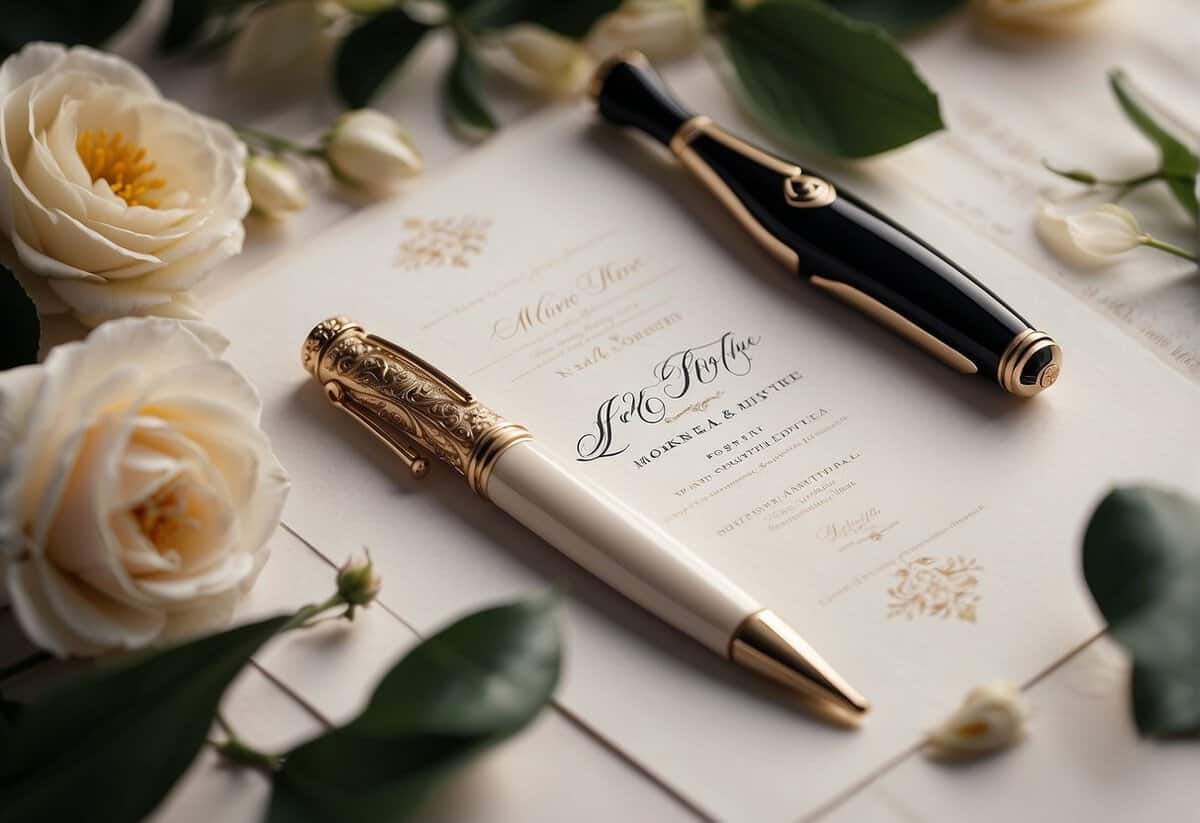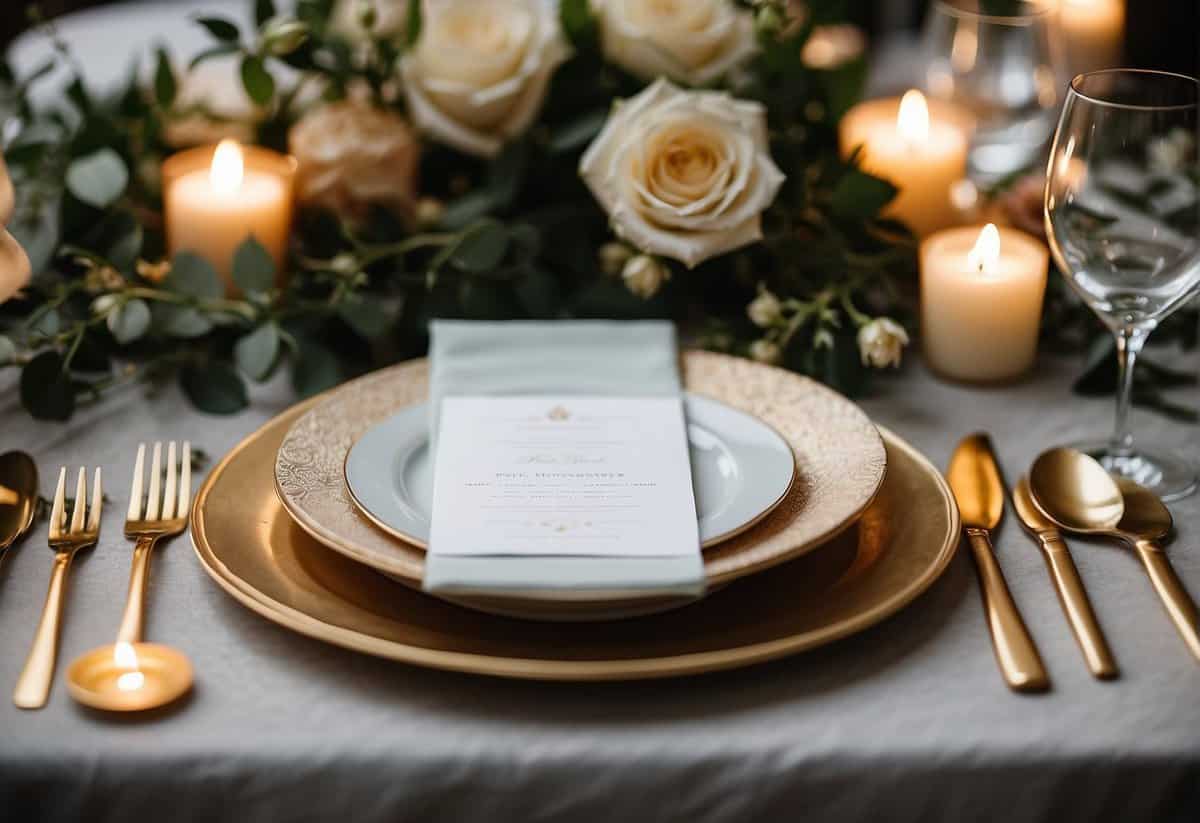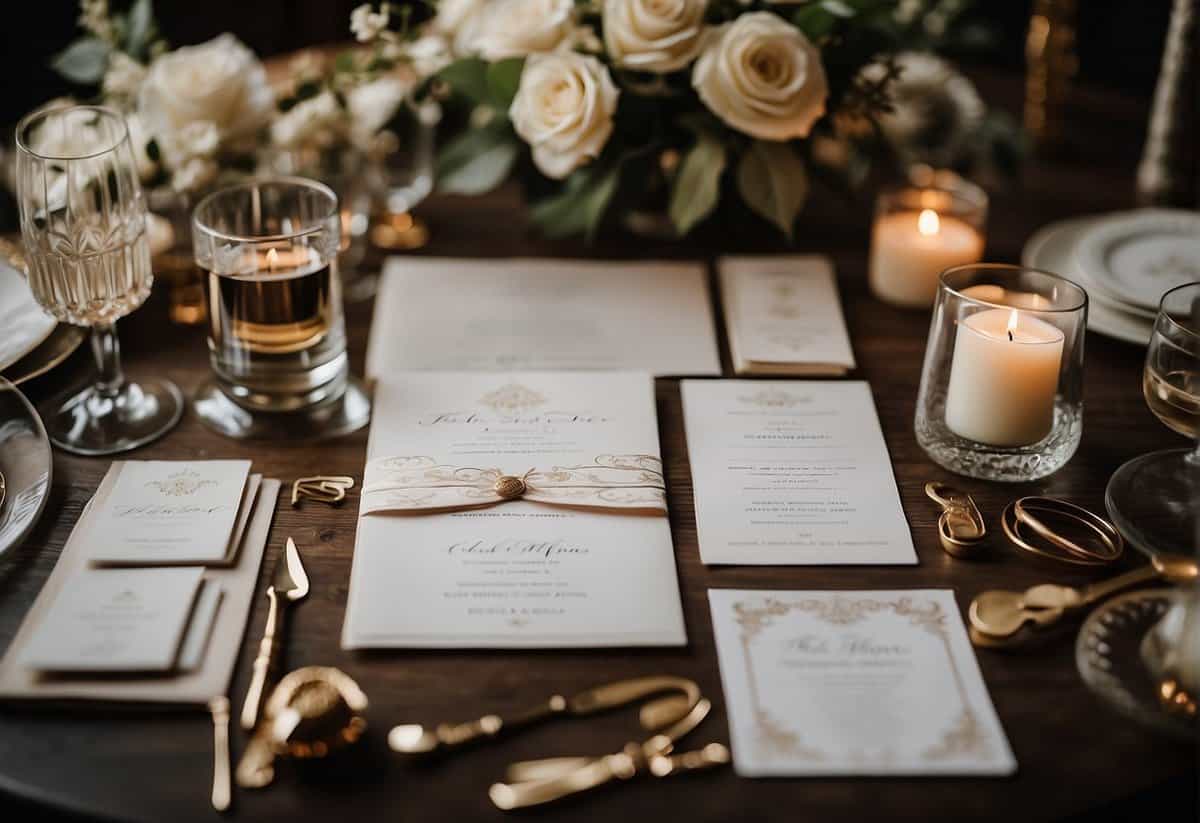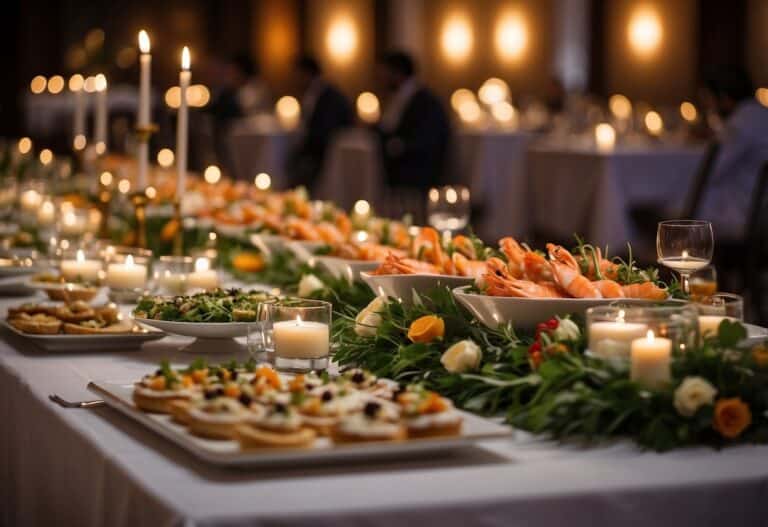Wedding Invitation Wording Ideas: Crafting Your Perfect Invite
Crafting the perfect wedding invitation wording is both an art and a practical challenge. Your wedding invitations not only convey the essential details about your big day but also set the tone for your wedding’s formality and style. Whether you’re aiming for traditional elegance or a more casual affair, the words you choose can warmly invite your guests to join in celebrating your nuptials. Remember, the key is to balance hospitality and personal touch with clear communication of your wedding event details.

As you embark on creating your invitations, considering the elements of who, what, when, and where is just the beginning. The wording structure and etiquette may vary depending on who is hosting the wedding, the type of ceremony you’re planning, and your desired invitation tone. From the invitation wording to the RSVP cards, every phrase is a reflection of your unique story and the joyous occasion you are sharing. Exploring various wording options helps ensure that your invitation resonates with sincerity and charm, guiding guests through the joyful journey of your wedding celebration.
Key Takeaways
- Your invitation wording sets the tone for your wedding’s formality and style.
- It’s important to communicate clear details about the wedding while adding personal touches.
- Balancing tradition with modern etiquette can result in a heartfelt invitation.
Understanding Wedding Invitation Wording

Crafting the perfect wedding invitation wording is essential as it sets the stage for your special day and informs guests of all the necessary details. Let’s explore the interplay of tradition, the importance of identifying the hosts, and how to convey the right tone to ensure your invitations echo your unique celebration.
The Role of Tradition
Tradition often guides the structure and phrasing of wedding invitation wording. Typically, a traditional wedding invitation will follow a certain etiquette, bearing phrases like “request the honor of your presence” for a religious ceremony or “request the pleasure of your company” for a secular one. If you’re honoring tradition, these time-tested formats provide a sense of formality and respect.
Identifying the Hosts
The host line of your wedding invitation is crucial as it indicates who is hosting the event. Historically, the bride’s parents were the default hosts, but modern practices include both sets of parents, various family members, or even the couple themselves. For example:
- Formal wedding invitation wording might start with:
- “Mr. and Mrs. John Smith…”
- Casual wedding invitation wording might read:
- “Together with their families…”
Your choice here reflects not just who is organizing the event but also the nature of the celebration.
Conveying the Tone
You set the tone of your wedding through the language of the invitation. Formal wedding invitation wording creates a more traditional and ceremonial atmosphere, while casual wedding invitation wording can make guests feel they’re in for a relaxed celebration. If you’re looking for something less conventional, unique wedding invitation wording allows you to showcase your creativity and personal style. Remember, the tone you choose should match the overall vibe of your wedding, from the venue to the decor.
Details to Include in Your Invitation

Crafting your wedding invitations involves more than just aesthetic choices—it’s about providing guests with the necessary details for your special day. Here’s a breakdown of the essential information to include:
Date and Time
Ceremony Start Time: Ensure your invitation clearly states the date and time the ceremony will begin to avoid any confusion. It’s traditional to write out the date in words and to include both the day of the week and the year.
Example:
Saturday, the fifth of June
Two thousand twenty-four
at half-past four in the afternoon
Location Essentials
Ceremony Venue: The location should be specific, including the full address of your ceremony site. If it’s taking place at a well-known location, the name alone might suffice, but always consider out-of-town guests who will appreciate the full details.
Example:
The Rose Garden Pavilion at
Elmwood Park
123 Garden Drive
Springfield, Illinois
Reception Information
Celebration to Follow: If your reception is at the same location as your ceremony, a simple “Reception to follow” will do. For a different location, provide the address and start time. Consider including reception details about the nature of the event (formal dinner, cocktail reception, etc.).
Example:
Reception to follow at
The Grand Ballroom
456 Celebration Avenue
Springfield, Illinois
Cocktail hour starts at six o’clock
RSVP and Accommodation
RSVP Card: Your invitation suite should come with an RSVP card that asks guests to respond by a specific date. Provide a stamped envelope or an alternative method to reply, like an email address or wedding website.
Accommodation Details: For guests traveling from out of town, inform them of any reserved hotel blocks or accommodations. Details like a response by date are crucial for final headcounts and travel arrangements.
Table Example:
| Please respond by | Accommodation Information |
|---|---|
| July 20th, 2024 | A block of rooms has been reserved at the Springfield Suites. Visit our wedding website or call (123) 456-7890 for booking details. |
Incorporating all of these elements will ensure your guests are well-informed and can celebrate with you without any hitches.
Wording Structure and Etiquette

The wording of your wedding invitation not only conveys the essential details but also sets the tone for your special day. Proper etiquette and clarity are paramount, so let’s look at how to address your guests, the considerations for invitation design, and the importance of using clear language.
Addressing the Guests
When addressing your guests, use their appropriate titles such as “Mr.,” “Mrs.,” or “Ms.” For couples, list both names, and for families, include the children’s names on the second line. Remember, the outer envelope can be more formal, using full names and titles, while the inner envelope can be less so, referring to guests by first names or familiar titles.
Invitation Design Considerations
Your invitation design should match the formality of your event. A black-tie affair might feature elegant script fonts and a formal language structure, while a casual beach wedding might opt for a lighter tone and playful design. Additionally, it’s crucial to consider the font and text size for readability—make sure your guests can easily read the details of your big day.
The Importance of Clarity
Clarity in invitation wording ensures guests understand the event’s details without confusion. Be sure to include the full names of the couple getting married and the specific details of the location and time. If there’s a dress code, make it evident by phrases like “black-tie attire requested.” Avoid ambiguity by being direct and straightforward, which honors proper etiquette while respecting your guests’ need for clear information.
Special Circumstances in Invitations

Your wedding invitation wording can honor and reflect unique family situations with sensitivity and respect. Navigate these circumstances with clarity using the guidelines below.
Including Children
When you’re excited to invite guests and their families to your wedding, make it clear by including a line on your invitation. You could use wording such as “Children welcome” or, more formally, “The pleasure of your and your children’s company is requested”.
Honoring Deceased Parents
It’s a beautiful gesture to include a deceased parent in your wedding invitations. Consider phrasing such as “In loving memory of [Name], we invite you to join…” which respectfully acknowledges their place in your heart and your celebration.
Celebrating Divorced and Stepparents
Acknowledging blended families on invitations is an act of inclusivity. List parents and stepparents on separate lines to avoid confusion. For instance:
- Jane Doe and John Smith
- Together with their parents
- Linda Doe and Robert Black,
- Michelle Smith and Alan Green
Embracing Same-Sex Unions
Same-sex couples often seek wording that resonates with the spirit of their union. A simple and heartfelt invitation might read, “You are joyfully invited to the marriage of [Partner A] and [Partner B]”. Choose language that feels authentic to your relationship.
Extras and Final Touches

In the realm of wedding invitations, the devil is in the details. It’s the thoughtful extras and final flourishes that create a memorable suite and guide your guests through each step of your wedding journey.
Enclosure Cards
Enclosure cards are a key component in wedding stationery, meant to provide your guests with all the essential details. Typically, this includes:
- RSVP cards, imperative for a timely headcount.
- Detailed directions or accommodation information, to ensure everyone arrives without a hitch.
Think of them as the road map that compliments your main invite—concise, clear, and in the same design vein.
Personalizing with Design
Your wedding invitation design is a reflection of your personal style. Consider incorporating a monogram featuring yours and the groom’s name, a design element that can be carried across your entire wedding station. Choose fonts and color palettes that resonate with the theme of your wedding to create a cohesive and charming first impression.
Digital Invitations
Embracing the digital age, digital invitations offer a modern twist to traditional paper invites. They are not only cost-effective but also environmentally friendly. Here’s how you can maximize their potential:
- Include animations or interactive elements for a dynamic experience.
- Embed your wedding website URL directly into the invite, providing guests with easy access to additional info.
Following Up with Save-the-Dates
Save-the-dates play a pivotal role in building anticipation for your special day. They should ideally go out several months before your wedding and can serve as a sneak peek into the style of your main invitation. Simple personal touches, like a photo of the two of you or a handpicked design, can make them feel truly yours.
By focusing on these extras and final touches, your wedding invitations will not only share your news but also set the stage for your upcoming celebration.

